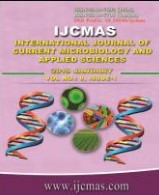


 National Academy of Agricultural Sciences (NAAS)
National Academy of Agricultural Sciences (NAAS)

|
PRINT ISSN : 2319-7692
Online ISSN : 2319-7706 Issues : 12 per year Publisher : Excellent Publishers Email : editorijcmas@gmail.com / submit@ijcmas.com Editor-in-chief: Dr.M.Prakash Index Copernicus ICV 2018: 95.39 NAAS RATING 2020: 5.38 |
An experiment was conducted to study the bio-efficacy of native bioagent and biofertilizer for the management of root-knot nematode Meloidogyne incognita infecting black gram Vigna mungo. For this the bioagents, Pseudomonas fluorescens, Bacillus megaterium, Pochonia chlamydosporia and Purpureocillium lilacinum and biofertilizers like Azotobacter sp. and Rhizobium sp. were screened against M. incognita by using seed treatment under pot condition. Further, these bioagents and bioferilizers were compared with an uninoculated check; an inoculated check and a chemical check (Carbosulfan 25 EC @ 0.2%) were used as control treatments. The results of the pot experiment revealed that all the tested bioagents and biofertilizers were improved plant growth parameters of blackgram and reduced the nematode multiplication in the soil. The maximum plant growth parameter of blackgram was recorded in the treatment with untreated and uninoculated control (T9) followed by the treatment T7 i.e seed soaking with carbosulfan 25 EC @ 0.2%. However, the minimum nematode multiplication was recorded in the treatment T7 i.e., seed soaking with carbosulfan 25 EC @ 0.2%. It observed that bacterial bioagents showed more bioefficacy than fungal bioagents. Among the bioagents the treatment T6 i.e., seed treatment with Pseudomonas fluorescens @ 1% (v/w) and between biofertilizers, the treatment T4 i.e., seed treatment with Azotobacter spp. @ 1% (w/w) were found to be the best in respect of giving the maximum shoot and root length, fresh shoot and root weight, dry shoot and root weight of blackgram and reducing the minimum number of galls per root system, egg masses per rot system and final J2s population of M. incognita in the soil.
 |
 |
 |
 |
 |